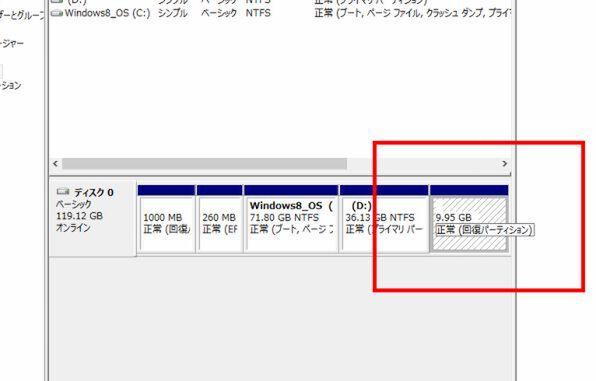ASCII.jp 8.1 Save the system with the "recovery" function of Windows 8 before the appearance
From Windows 8, functions such as reinstalling the system are standard equipment.This time, let's explain one of them, "recovery".In addition, since the release of Windows 8.1 is already near, in this series, the case where only the first released Windows 8 is described is "8.0".
Looking at the description of Windows 8, the term "recovery" and "recovery image" appear.This "image" refers to a dedicated file (WIM format file) that records the status of Windows.
If you create a recovery image, you can always return the Windows system to that state.
Unlike an archive file that summarizes general files and multiple files, this image file can be "mounted" as a drive, and if you mount it, functions such as general file copies like HDD.Can be used.For this reason, unlike the archive format, there is no need to create a temporary file on the disk.
A recovery partition is used for recovery on a PC made of Windows 8
This recovery image has the following three "preservation forms".
Recovery partition recovery drive recovery image file
Understanding this distinction is the point of understanding the recovery function of Windows 8.

First is the "recovery partition".This is a machine where Windows 8 is pre -installed, such as a manufacturer's PC, and a partition that preserves a "recovery image file" to return the system to a factory shipment (logically split the physical HDD memory area.It refers to the area you did).
A recovery image file is usually stored in a recovery partition on a manufacturer PC with Windows 8 installed.
In general, in the Windows 8 system, this is the "default recovery image".This is different from the partition where Windows is installed, so unless you perform partition operation again, you will not be able to access it with normal file operation and will not be erased by mistake.
In addition, in case the Windows partition becomes unreadable, the manufacturer's PC has an environment "Windows Re" installed to return the system, and the system is used to return the system to the worst factory shipping using the recovery partition.It is possible to launch Windows.
The second "recovery drive" refers to a USB memory or a DVD disc to launch the system using this recovery partition.After all, Windows Re is incorporated and it is possible to start the system.
The recovery image file is a file that records Windows itself and settings, such as a Windows system program, and includes this recovery image file in recovery partitions and recovery drives.However, the recovery partition contains a variety of functions (for example, HDD re -format) to return the system to factory shipment, and the Windows Re, a mini -version Windows Re that runs these functions, etc.It is a set.
The recovery image file for recovery can be created at the time of the user
On the other hand, if you use the tool (Recimg command) attached to Windows 8, you can create a recovery image file of Windows currently used.If you use this recovery image file, you can use that image to initialize the system.
In other words, instead of returning to the state at the time of shipment like a manufacturer's PC.When the system is recovered using this recovery image file, the program installed by the user is included in the recovery image.In other words, the user can save it in that state of creating your favorite environment.
The recovery image file includes "Program Files" (including X86), Programdata (hidden folder), "Windows", "User" (but only Default and Public) and Config.sys, AutoExec.bat,It contains three files, Recovery.txt.In addition, user data is not included at all.
Windows also has the term "restoration" very similar to "recovery".This is a function to record and cancel it later when installing or updating a device driver.In Windows, be careful not to confuse it because this "restoration" is handled by "recovery" of the control panel.